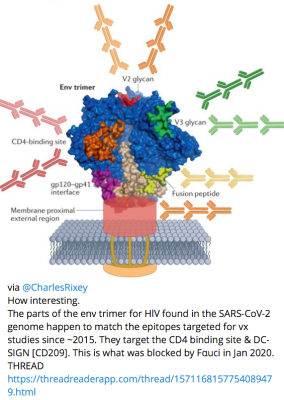Table of Contents
SARS-CoV-2
SARS-CoV-2 is a humanborne coronavirus in the betacoronavirus family. The emergence of SARS-CoV-2 led to the SARS-CoV-2 pandemic to be declared by the World Health Organization.
SARS-CoV-2 stands for Severe Acute Respiratory Syndrome Coronavirus 2. It is named as such due to its relative similarity to the SARS coronavirus that led to a public health emergency in parts of the world in 2003.1) 2)
The SARS-CoV-2 virus is a close genetic relative of two other infamous viruses from recent history: SARS-CoV and MERS-CoV.3)
threadreader for inage 4)
SARS-CoV-2 Viral Mechanisms and Characteristics
SARS-CoV-2 is a positively charged, single-stranded RNA virus.
Features
Pathology
- Dec, 2020 - Liao et al; SARS-CoV-2 in the bile of a patient with COVID-19-associated gallbladder disease.5)
Researchers have found in autopsies that SARS-CoV-2 does get into brain tissue, and can be present for months after infection, though inflammation outside of the lungs was mild.6)
See Spike Protein for a discussion of toxins.
Transmission and Infectivity
Nearly two years into the COVID-19 pandemic, some aspects of transmission is still debated. Contact tracing research out of China showed no asymptomatic viral transmission at all.7) Other research indicates that symptomatic transmission drives the pandemic, but there may be smaller amounts of asymptomatic and presymptomatic spread.8) 9) 10)
Further reading:
- Jan 7, 2021 - Johansson et al; Asymptomatic and presymptomatic spread 25% less.11)
Aerosolization and Transmissibility
Throughout the pandemic, evidence has piled up suggesting that all or nearly all SARS-CoV-2 tranmission takes place through aerosolized virion particles.12) While Goldberg drum experiments suggested that SARS-CoV-2 could hang in the air for up to three hours,13) more sophisticated experiments showed SARS-CoV-2 aerosols to be viable for only around 20 minutes.14)
Indoor/Outdoor Transmission
SARS-CoV-2 is a highly aerosolized virus, and research shows that nearly all transmission takes place in indoor settings where a poorly ventilated room can fill to a pressurized level with virions. One study (preprint) found that 95% of primary case transmission in Japan took place in closed environments.15)
= Transmission among Children and in Schools = Early during the pandemic, there was great debate over whether or not children could transmit SARS-CoV-2 to adults. If they cannot, then they likely cannot generate viral loads enough to get sick. It is likely that they rarely, but sometimes do develop sufficient viral load to get sick and also transmit, but this may happen most off with children who are immunodeficient or immunocompromised.
- Apr 30, 2020 - Business Insider suggests summary evidence points to some spread by children.16)
- Mar 19, 2021 Bismarck-Osten et al. The Role of Schools in Transmission of the SARS-CoV-2 Virus: Quasi-Experimental Evidence from Germany.
- School closures had no significant impact on spread of SARS-CoV-2 either among the children in spill-over effects to older generations. School opening had no impacts, and lower transmission incidence was seen.
Animal Transmission
Early during the COVID-19 pandemic, many laboratories euthanized mice as a preventative measure.17)
Pathways and Cell Entry
At least one research team argues that there is evidence of infection and shed from the human gastrointestinal tract.18)
ACE2 and TMPRSS2 and bears, oh my!
Some research indicates neuroinvasion of SARS-CoV-2: https://www.youtube.com/watch?v=fNFzfwLM72c&t=2s
Fat Cells
Once inside the body, SARS-CoV-2 may infect human adipose tissue, which may be one of the reasons obesity is so highly associated with the COVID-19 disease state and long haul COVID-19 symptoms.19)
Infectivity in Animal Hosts
COVID-19 animal infection tracker
Numerous animals aside from humans have been noted to be susceptible to SARS-CoV-2 infection. Comparative and structural analysis on 410 vertebrate species predicts a broad host range for infection, specifically among mammals.20) One study still in preprint found SARS-CoV-2 moving rapidly into white-tailed deer populations in North America, with over 80% of the deer testing PCR positive for the virus by early 2021.21)
Immunity
There are competing theories on how people can build immunity to SARS-CoV-2 infection or the resulting COVID-19 disease state.
Herd Immunity
Herd immunity is the condition in which viral outbreaks become rare due to sufficiently low transmission rates of a pathogen. This topic has become controversial during the SARS-CoV-2 pandemic due to a combination of propaganda and changing transmission rates of SARS-CoV-2 variants of interest.
Natural Immunity
See natural immunity.
Reinfections
During the early part of the COVID-19 pandemic, physicians and scientists found that reinfections were extremely rare.22)
During the omicron era, reinfections are rapidly on the rise.23)
Transference of Immunity
Scientists have noted evidence for aerosol transfer of SARS-CoV-2-specific humoral immunity.24)
Disease
COVID-19
SARS-CoV-2 is a cause of COVID-19, a disease with wide ranging characteristics primarily affecting the respiratory and vascular systems.
Genetic and Epigenetic Effects of Infection
Chromatin Architecture
- SARS-CoV-2 Restructures the Host Chromatin Architecture25)
Mutation and Variants
There is debate over the nature of the mutations of SARS-CoV-2, its causes, and the implications. This includes theories that non-sterile COVID-19 vaccines sift virions, generating immunity escape.
See more at SARS-CoV-2 Variants
Controversies
SARS-CoV-2 Origins Story Controversy
The origins of SARS-CoV-2 are shrowded in mystery, including whether the virus is zoonotic or manmade, or was released accidentially or intentionaly.
Retracted Research
Many papers have been retracted during the COVID-19 pandemic. Here are some that relate specifically to SARS-CoV-2, though others may be found at Retraction Watch.
- SARS-CoV-2 Spike Impairs DNA Damage Repair and Inhibits V(D)J Recombination In Vitro26)

